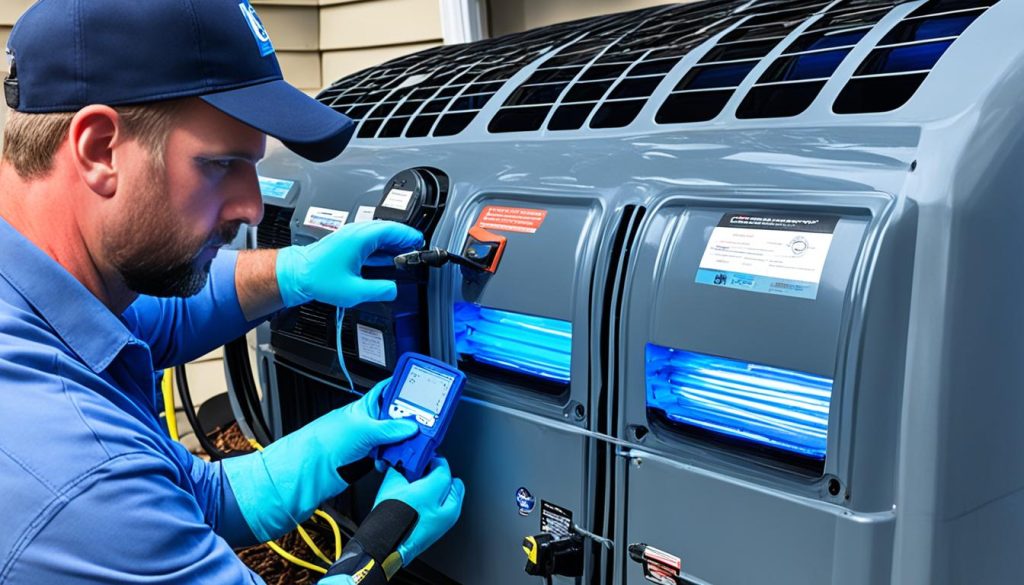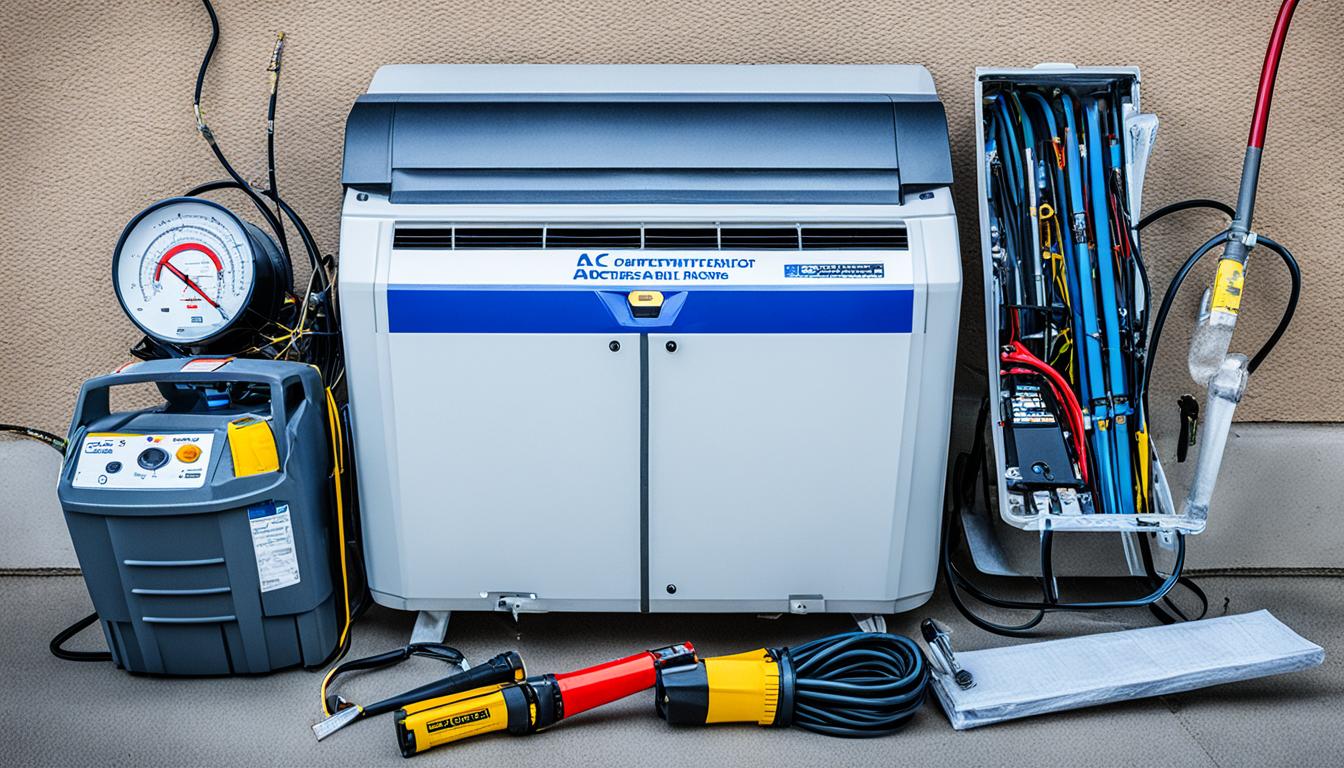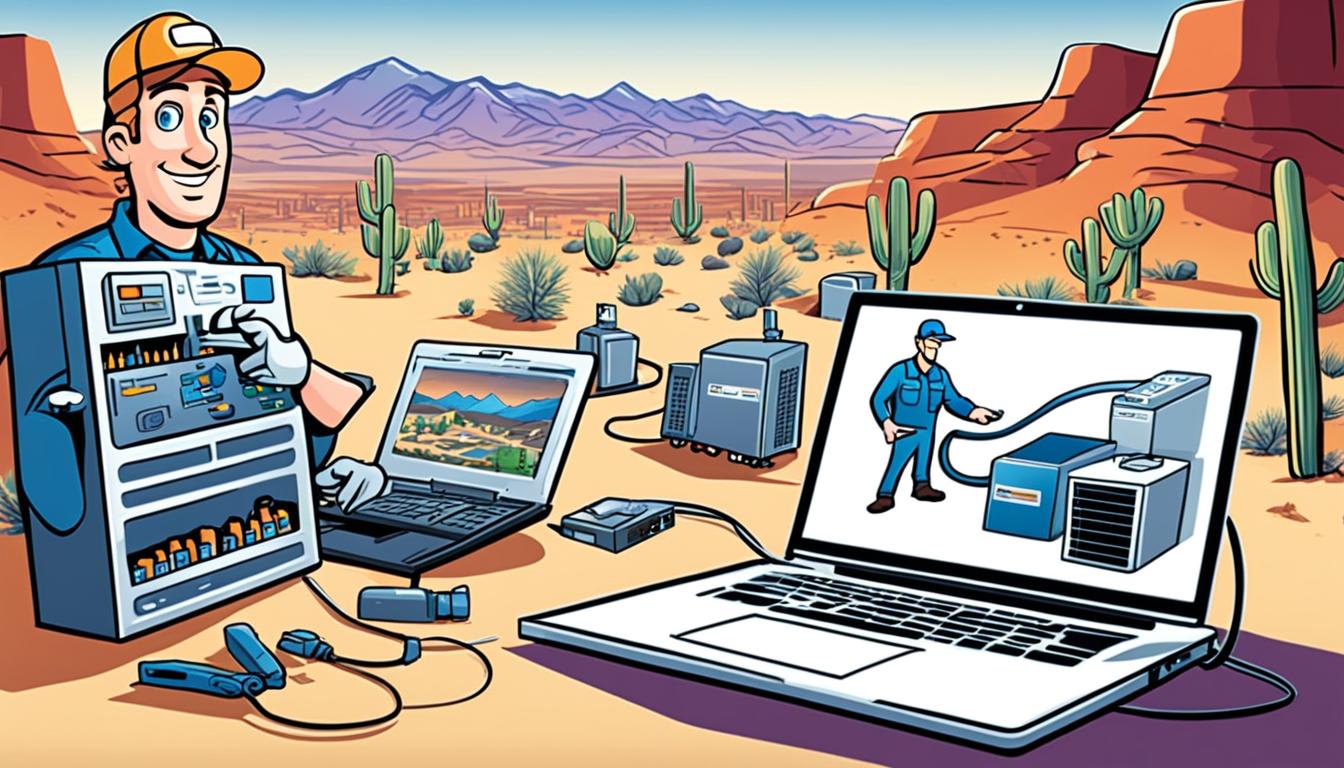Imagine this: it’s the sweltering heat of summer, and your air conditioning system suddenly stops cooling your home. You feel the frustration building as you realize that your AC system might have a leak. But here’s the catch – your AC system is old, and detecting leaks in older systems can be a real challenge.
As an experienced AC repair contractor, you’ve likely encountered this frustrating situation more than once. Older AC systems come with their own set of unique challenges when it comes to leak detection. Worn-out components and outdated technology can make it harder to pinpoint the source of the leak.
But fear not! There are solutions to this problem. In this article, we will explore the challenges of detecting leaks in older AC systems and provide you with actionable insights and strategies to overcome them. So, let’s dive in and equip you with the knowledge you need to tackle this common issue head-on.
Key Takeaways:
- Detecting leaks in older AC systems can be challenging due to worn-out components and outdated technology.
- Signs of AC system leaks in older units include reduced cooling efficiency, decreased airflow, hissing sounds, and more frequent refrigerant recharge.
- Various leak detection methods, such as visual inspections, electronic leak detectors, dye tests, and ultrasonic leak detection, can help identify the location of leaks.
- Overcoming challenges in detecting leaks in older AC systems requires using appropriate leak detection methods, such as pressure testing, infrared thermography, and electronic leak detectors.
- Regular maintenance and inspections play a crucial role in identifying and addressing potential leaks before they become major issues.
Common issues with detecting leaks in older AC systems
When dealing with older AC systems, it is important to be aware of the signs that indicate the presence of leaks. These signs can help you identify and address potential issues promptly, ensuring the optimal performance of the system.
Symptoms of AC system leaks in older units include:
- Reduced cooling efficiency: If the air coming from the AC vents is not as cold as it used to be, it could be a sign of a refrigerant leak.
- Decreased airflow: Insufficient airflow can indicate a problem with the AC system, potentially caused by leaks.
- Hissing sounds: Unusual hissing or bubbling noises could indicate leaks in the AC system.
- More frequent refrigerant recharge: If the AC system requires frequent refrigerant recharge, it is a strong indication of leaks.
Knowing the signs is only the first step. To find leaks in aging AC systems, there are several techniques that can be employed:
- Visual inspections: Inspecting the AC system for any visible signs of leaks, such as oil spots or refrigerant stains, can help pinpoint the location of a leak.
- Electronic leak detectors: These devices can quickly and accurately detect refrigerant leaks by sensing halogen gases in the air.
- Dye tests: Injecting a fluorescent dye into the AC system and then using a UV light can reveal the location of leaks, as the dye will glow under the UV light.
- Ultrasonic leak detection methods: Using ultrasonic technology, sound waves are used to detect the high-frequency noise emitted by AC system leaks. This method can help identify leaks that are not visible to the naked eye.
By using these techniques, AC repair technicians can effectively identify and locate leaks in older AC systems, facilitating the repair process and ensuring the system operates efficiently.
Overcoming challenges in detecting leaks in older AC systems

To effectively detect leaks in older AC systems, it is crucial to use appropriate AC leak detection methods. These methods can help overcome the unique challenges posed by aging air conditioning units and ensure optimal performance. Here are some common techniques to consider:
- Pressure testing: This method involves pressurizing the AC system with nitrogen or helium to identify leaks. By introducing a higher pressure, technicians can detect any drop in pressure that indicates a leak. Pressure testing is especially useful for pinpointing hard-to-find leaks in older AC systems.
- Infrared thermography: Infrared thermography utilizes thermal imaging to detect temperature variations caused by leaks. By using a specialized camera, technicians can identify areas where there is a temperature difference, indicating the presence of a refrigerant leak. This non-intrusive method is particularly helpful for detecting leaks in larger areas or components that are difficult to access.
- Electronic leak detectors: Electronic leak detectors can detect refrigerant leaks by sensing halogen gases. These handheld devices are highly sensitive and can quickly identify leaks in older AC systems. Technicians sweep the detector over the AC system, and the device provides audio or visual signals when a leak is detected.
In addition to these specific detection methods, regular maintenance and inspections play a vital role in identifying and addressing potential leaks before they become major issues. By conducting routine checks and staying proactive, AC repair contractors can effectively detect and repair leaks, ensuring optimal performance and prolonging the lifespan of older air conditioning systems.
Benefits of using appropriate AC leak detection methods
Utilizing the right AC leak detection methods brings several benefits to older systems:
- Optimal efficiency: Detecting and repairing leaks improves the efficiency of older AC systems, allowing them to cool more effectively and reducing energy consumption.
- Prolonged lifespan: Timely detection and repair of leaks can prevent further damage and extend the overall lifespan of an older AC system, saving homeowners from costly replacements.
- Cost savings: By maintaining optimal efficiency, homeowners can enjoy lower energy bills as their AC systems operate more efficiently, reducing operational costs.
- Environmental benefits: Preventing refrigerant leaks by using proper detection methods helps reduce the environmental impact associated with AC systems, as leaked gases contribute to ozone depletion and climate change.
By utilizing these effective AC leak detection methods and prioritizing regular maintenance, AC repair contractors can ensure the long-term performance and efficiency of older AC systems, benefitting both homeowners and the environment.
Importance of leak detection in older AC systems
Detecting leaks in older AC systems is essential for maintaining their efficiency and prolonging their lifespan. Leaks in these systems can result in refrigerant loss, which not only reduces cooling capacity but also increases energy consumption. By regularly inspecting and detecting leaks, AC repair contractors can ensure that older AC systems operate at optimal efficiency, saving energy and reducing operational costs for homeowners.
Older AC systems are more susceptible to leaks due to worn-out components and outdated technology. These leaks can go unnoticed, leading to reduced performance and increased wear and tear on the system. Regular leak detection allows technicians to identify and address leaks promptly, preventing further damage and extending the overall lifespan of the air conditioning unit.
Moreover, AC leak detection services play a critical role in maintaining the efficiency of older AC systems. when leaks go undetected, the cooling capacity of the unit is compromised. This not only results in reduced comfort but also forces the system to work harder to maintain the desired temperature. By detecting and repairing leaks, contractors can ensure that the system operates at its intended efficiency, providing optimal cooling performance and helping homeowners save on energy bills.
In conclusion, the importance of leak detection in older AC systems cannot be overstated. Regular inspections and prompt detection not only prevent further damage but also help maintain the efficiency and prolong the lifespan of the unit. AC repair contractors should prioritize leak detection services to ensure optimal performance and customer satisfaction.





0 Comments